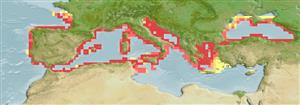Preferred temperature (Ref.
123201): 10.3 - 17.3, mean 15.1 °C (based on 59 cells).
Phylogenetic diversity index (Ref.
82804): PD
50 = 0.5001 [Uniqueness, from 0.5 = low to 2.0 = high].
Bayesian length-weight: a=0.00741 (0.00567 - 0.00970), b=3.06 (3.02 - 3.10), in cm total length, based on LWR estimates for this species (Ref.
93245).
Trophic level (Ref.
69278): 3.4 ±0.45 se; based on food items.
Widerstandsfähigkeit (Ref.
120179): mittel, Verdopplung der Population dauert 1,4 - 4,4 Jahre. (tm=1; Assuming fec < 10,000).
Fishing Vulnerability (Ref.
59153): Low vulnerability (10 of 100).
🛈
Nutrients (Ref.
124155): Calcium = 266 [111, 608] mg/100g; Iron = 1.59 [0.84, 3.13] mg/100g; Protein = 18.6 [16.7, 20.2] %; Omega3 = 0.463 [0.200, 0.887] g/100g; Selenium = 18.1 [8.0, 39.9] μg/100g; VitaminA = 21.3 [6.5, 65.5] μg/100g; Zinc = 1.59 [1.05, 2.36] mg/100g (wet weight);
